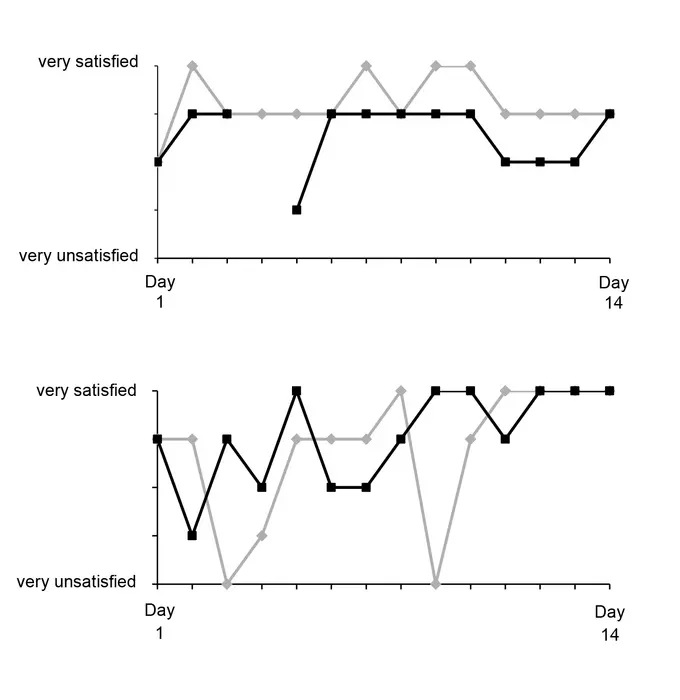In the intricate dance of human relationships, satisfaction between romantic partners has long been recognized as a cornerstone of both emotional well-being and relational longevity. A groundbreaking psychological study led by Louisa Scheling at Johannes Gutenberg University Mainz now sheds unprecedented light on the dynamic nature of relationship satisfaction by uncovering how it fluctuates on a daily and even hourly basis. Contrary to the traditional view that evaluates satisfaction as a stable, long-term trait, this research reveals continuous, measurable swings that not only characterize modern partnerships but also synchronize intriguingly between partners.
The prevailing scientific approach has often examined relationship satisfaction over extended periods, spanning months or years, providing valuable insights into general trends but lacking temporal granularity. Scheling and her interdisciplinary team chose a novel route: collecting high-frequency data through daily and several-times-daily surveys to capture the ephemeral yet meaningful oscillations in romantic contentment. These meticulous assessments involved nearly 600 couples in one study and another 150 in a subsequent sample, creating a robust dataset for temporal mapping of satisfaction within relationships.
One of the most compelling revelations of the study is the magnitude and synchronicity of fluctuations experienced by partners. Individuals reported notable variances in how content they felt about their relationships from one day to another, with more pronounced variability over several days compared to shorter intervals within a 24-hour cycle. Interestingly, partners’ independent assessments tended to rise and fall in tandem, suggesting an underlying mutual attunement that could be reflective of shared emotional climates or reciprocal responsiveness.
Delving deeper into potential moderating factors, the research team explored variables including age, gender, duration of relationship, and attachment style, with a striking outcome: the perceived responsiveness of a partner emerged as a pivotal determinant of relationship satisfaction stability. Partners who felt acknowledged and understood by their significant others demonstrated less fluctuation and higher average satisfaction. This nuance highlights the critical role of emotional attunement and the fulfilling of relational needs in fostering harmony and resilience.
Male emotional instability also surfaced as a notable influence, underscoring the complexity of how individual traits can reverberate within relational dynamics. When men experienced heightened emotional volatility, this unpredictability was mirrored in more fluctuating satisfaction levels for both members of the couple. The findings echo psychological theories emphasizing the bidirectional nature of affect regulation and attachment, emphasizing that personal emotional states ripple through relational exchanges with palpable effects.
Scheling eloquently captures the essence of these results by drawing parallels to parent-child relationships. Just as consistent fulfillment of needs between caregivers and children stabilizes attachment and emotional security, so too does mutual recognition and responsiveness between romantic partners cultivate a steady course of relational satisfaction. This analogy enriches the conceptual landscape, bridging developmental psychology and adult romantic attachments under the umbrella of fundamental human needs.
Importantly, the study nuances our understanding of how fluctuations in satisfaction relate to broader relationship trajectories. While short-term dips and surges may precipitate immediate thoughts of separation or doubt, the longitudinal impact appears limited. Instead, these day-to-day movements seem to echo the current state of relational dynamics rather than reliably forecasting future dissolution. This insight recalibrates long-standing assumptions, inviting clinicians and couples alike to view satisfaction variability as a natural and informative feature rather than a harbinger of doom.
The implications for therapeutic practice and relationship counseling are profound. Recognizing that short-term fluctuations in satisfaction are normative opens the door to using these oscillations as diagnostic tools. Couples can be encouraged to articulate unmet needs when they notice dips, transforming potentially destabilizing fluctuations into catalysts for communication and growth. The study emphasizes the necessity for partners to possess self-awareness and clear expressive abilities to harness these signals constructively.
Technically, the use of intensive longitudinal designs with frequent data collection marks a methodological advancement in relationship science. This approach not only captures the within-person variability but also models the temporal synchrony between dyads with sophisticated statistical techniques. The result is a fine-grained, dynamic portrait of relationship satisfaction that transcends static cross-sectional snapshots.
Moreover, the global and collaborative nature of the research, involving institutions across Germany, Switzerland, and the USA, underscores the universal relevance of these findings. Given the high rates of dissolution in both marriages and cohabiting partnerships globally, understanding the short-term fluctuations provides a nuanced framework for preventive interventions aimed at sustaining relational quality and, consequently, broader well-being.
From a broader psychological perspective, the study challenges dichotomous interpretations of relationship quality as simply ‘good’ or ‘bad,’ highlighting its fluidity and the normative oscillations inherent in human connection. It invites a shift towards embracing complexity, acknowledging that relationships are living systems marked by fluctuations that both reflect and shape partners’ interpersonal environments.
Louisa Scheling’s compelling research thus illuminates the transient yet synchronized shifts in romantic satisfaction, presenting a dynamic model that accords with lived experiences more authentically than prior static assessments. The findings hold promise not only for enriching academic discourse but also for empowering individuals and couples to navigate the ebbs and flows of love with greater insight and resilience.
In conclusion, the investigation into the micro-temporal dynamics of relationship satisfaction opens fertile ground for future research, clinical innovation, and societal understanding. By foregrounding the normalcy and significance of short-term fluctuations, this work transforms how satisfaction is conceptualized and operationalized, promising a paradigm shift in relationship science and practice.
Subject of Research: Fluctuations and synchrony in romantic relationship satisfaction measured through high-frequency assessments.
Article Title: Within-person variability and couple synchrony in state relationship satisfaction: Testing predictors and implications
News Publication Date: 12 June 2025
Web References: https://doi.org/10.1037/pspp0000559
Image Credits: ill./© Louisa Scheling




